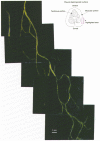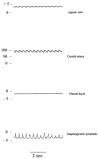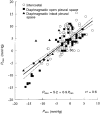Subatmospheric pressure in the rabbit pleural lymphatic network
- PMID: 10545142
- PMCID: PMC2269608
- DOI: 10.1111/j.1469-7793.1999.00761.x
Subatmospheric pressure in the rabbit pleural lymphatic network
Abstract
1. Hydraulic pressure in intercostal and diaphragmatic lymphatic vessels was measured through the micropuncture technique in 23 anaesthetised paralysed rabbits. Pleural lymphatic vessels with diameters ranging from 55 to 950 microm were observed under stereomicroscope view about 3-4 h after intrapleural injection of 20 % fluorescent dextrans. 2. Lymphatic pressure oscillated from a minimum (Pmin) to a maximum (Pmax) value, reflecting oscillations in phase with cardiac activity (cardiogenic oscillations) and lymphatic myogenic activity. With intact pleural space, Pmin in submesothelial diaphragmatic lymphatic vessels of the lateral apposition zone was -9.1 +/- 4.2 mmHg, more subatmospheric than the simultaneously recorded pleural liquid pressure amounting to -3.9 +/- 1.2 mmHg. In extrapleural intercostal lymphatic vessels Pmin averaged -1.3 +/- 2. 7 mmHg. 3. Cardiogenic pressure oscillations (Pmax - Pmin), were observed in all recordings; their mean amplitude was about 5 mmHg and was not dependent upon frequency of cardiac contraction, nor lymphatic vessel diameter, nor the Pmin value. 4. Intrinsic contractions of lymphatic vessel walls caused spontaneous pressure waves of about 7 mmHg in amplitude at a rate of 8 cycles min-1. 5. These results demonstrated the ability of pleural lymphatic vessels to generate pressure oscillations driving fluid from the subatmospheric pleural space into the lymphatic network.
Figures






 , central venous pressure. Bars represent ± 1
, central venous pressure. Bars represent ± 1 References
-
- Agostoni E. Mechanics of the pleural space. Physiological Reviews. 1972;52:57–128. - PubMed
-
- Benoit JN, Zawieja DC, Goodman AH, Granger HJ. Characterization of intact mesenteric lymphatic pump and its responsiveness to acute edemagenic stress. American Journal of Physiology. 1989;257:H2059–2069. - PubMed
-
- Lee JS. Tissue fluid pressure, lymph pressure and fluid transport in rat intestinal villi. Microvascular Research. 1986;31:170–183. - PubMed
Publication types
MeSH terms
LinkOut - more resources
Full Text Sources
Miscellaneous

